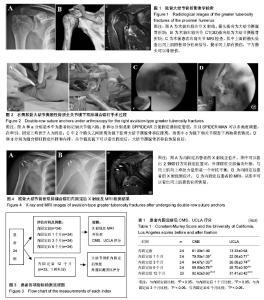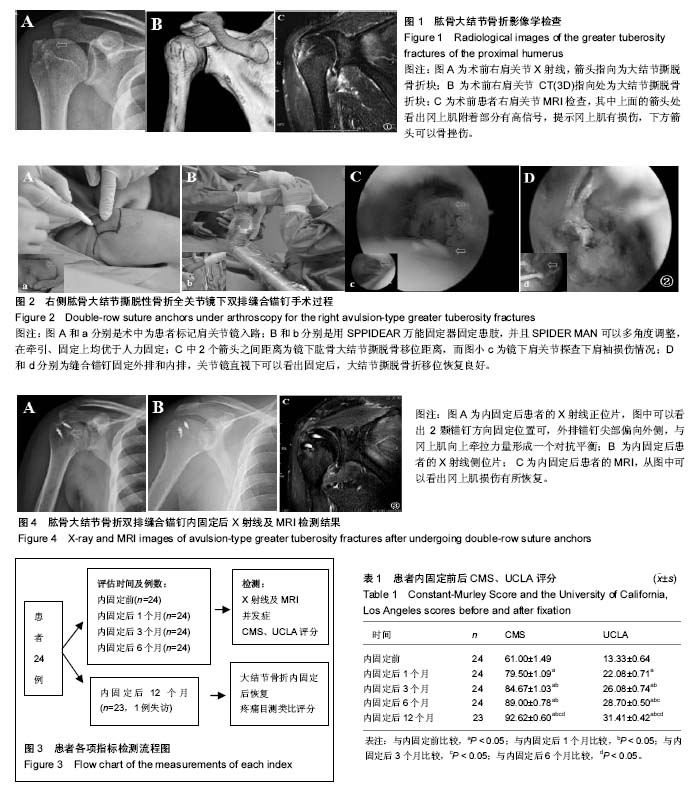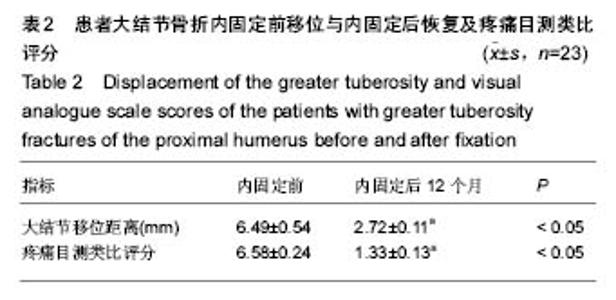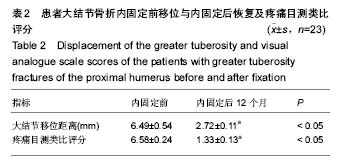| [1] Rouleau DM, Mutch J, Laflamme GY,et al.Surgical Treatment of Displaced Greater Tuberosity Fractures of the Humerus.J Am Acad Orthop Surg.2016;24(1):46-56.[2] Kannus P,Palvanen M,Niemi S,et al.Rate of proximal humeral fractures in older Finnish women between 1970 and 2007.Bone.2009;44(4):656-659.[3] Maman E, Dolkart O, Chechik O,et al.Arthroscopic findings of coexisting lesions with greater tuberosity fractures.Orthopedics.2014;37(3):e272-277.[4] DeBottis D, Anavian J, Green A,et al. Surgical management of isolated greater al.r tuberosity fractures of the proximal humerus. Orthop Clin North Am.2014;45(2):207-218.[5] Lill H , Katthagen C, Jensen G, et al. Arthroscopic fracture management in proximal humeral fractures. Unfallchirurg. 2013;116(4):296-304.[6] Taverna E , Sansone V, Battistella F, et al.Arthroscopic treatment for greater tuberosity fractures: rationale and surgical technique. Arthroscopy.2004;20(6):e53-57.[7] George MS. Fractures of the greater tuberosity of the humerus. J Am Acad Orthop Surg.2007;15:607-613.[8] Green A, Izzi J Jr. Isolated fractures of the greater tuberosity of the proximal humerus. J Shoulder Elbow Surg. 2003;12: 641-649.[9] Platzer P, Kutscha-Lissberg F, Lehr S, et al. The influence of displacement on shoulder function in patients with minimally displaced fractures of the greater tuberosity. Injury.2005;36: 1185-1189.[10] Bhatia DN,van Rooyen KS, du Toit DF,et al.Surgical treatment of comminuted,displaced fractures of the greater tuberosity of the proximal humerus: a new technique of double-row suture-anchor fixation and long-term results. Injury 2006;37: 946-952.[11] Neer CS 2nd. Displaced proximal humeral fractures. I. Classification and evaluation. J Bone Joint Surg Am. 1970; 52(6):1077-1089.[12] Mutch J, Laflamme GY, Hagemeister N,eta1.A new morphological classification for greater tuberosity fractures of the proximal humerus: validation and clinical implications. Bone Joint J.2014;96-B(5):646-651.[13] Bahrs C,Rolauffs B,Dietz K,et al. Clinical and radiological evaluation of minimally displaced proximal humeral fractures. Arch Orthop Trauma Surg.2010;130(5):673-679. [14] Xiang M , Chen H, Tang HC,et al. Treatment of two-part proximal humeral fracture with closed or mini-open assisted reduction and percutaneous pinning. Zhongguo Gu Shang. 2008;21(12):919-921.[15] Popp D, Schöffl V, Strecker W,et al. Osteosynthesis of displaced fractures of the greater tuberosity with the Bamberg plate. Oper Orthop Traumatol. 2016;28(5):392-401.[16] Park TS, Choi IY, Kim YH,et al. A new suggestion for the treatment of minimally displaced fractures ofthe greater tuberosity of the proximal humerus. Bull Hosp Jt Dis. 1997; 56(3):171-176. [17] Handoll HH , Brorson S.Interventions for treating proximal humeral fractures in adults.Cochrane Database Syst Rev. 2015;(11):CD000434.[18] Platzer P,Thalhammer G, Oberleitner G,et al.Displaced fractures of the greater tuberosity: a comparison of operative and nonoperative treatment.J Trauma. 2008;65(4):843-848. [19] Rath E, Alkrinawi N, Levy O,et al.Minimally displaced fractures of the greater tuberosity: outcome of non-operative treatment.J Shoulder Elbow Surg.2013;22(10):e8-e11.[20] Rouleau DM, Mutch J, Laflamme GY,et al.Surgical treatment of displaced greater tuberosity fractures of the humerus. J Am Acad Orthop Surg.2016;24(1): 46-56.[21] Kim DH, Elattrache NS, Tibone JE, et al.Biomechanical comparison of a single-row versus double-row suture anchortechnique for rotator cuff repair.Am J Sports Med.2006; 34(407-414.)[22] Kim SJ,Jung M,Lee JH ,et al.Arthroscopic repair of a significant (>50%) partial-thickness subscapularis tear concomitant with a full-thickness supraspinatus tear: technical considerations for subscapularis repair (transtendon technique versus tear completion).J Shoulder Elbow Surg. 2015;24(6):875-881.[23] Lin CL,Su FC ,Chang CH,et al. Effect of shoulder abduction on the fixation of humeral greater tuberosity fractures: a biomechanical study for three types of fixation constructs. J Shoulder Elbow Surg.2015;24(4):547-554.[24] Yang J Jr , Robbins M , Reilly J ,et al. The Clinical Effect of a Rotator Cuff Retear: A Meta-analysis of Arthroscopic Single-Row and Double-Row Repairs. Am J Sports Med. 2016 Jul 14. pii: 0363546516652900. [25] Park SE , Jeong JJ, Panchal K,et al. Arthroscopic-assisted plate fixation for displaced large-sized comminuted greater tuberosity fractures of proximal humerus: a novel surgical technique. Knee Surg Sports Traumatol Arthrosc.2015 Sep 29. [Epub ahead of print].[26] Liao W,Zhang H,Li Z,et al. Is Arthroscopic Technique Superior to Open Reduction Internal Fixation in the Treatment of Isolated Displaced Greater Tuberosity Fractures?. Clin Orthop Relat Res. 2016;474(5):1269-1279.[27] Duralde XA.CORR Insights: Is Arthroscopic Technique Superior to Open Reduction Internal Fixation in the Treat-ment of Isolated Displaced Greater Tuberosity Fractures? Clin Orthop Relat Res. 2016;474(5):1280-1282. [28] Ji JH ,Jeong JJ , Kim YY,et al.Clinical and radiologic outcomes of arthroscopic suture bridge repair for the greater tuberosity fractures of the proximal humerus.Arch Orthop Trauma Surg. 2017;137(1):9-17. [29] Gupta YS ,Ali S ,Ling S.Tendon pathology in trauma CT imaging: an under-recognized entity.Emerg Radiol. 2016; 23(5):513-520.[30] Li R, Cai M, Tao K.Arthroscopic reduction and fixation for displaced greater tuberosity fractures using the modified suture-bridge technique.Int Orthop.2017;41(6):1257-1263. |



